Charles E W Bean, Diaries, AWM38 3DRL 606/243A/1 - 1916 - 1934 - Part 17
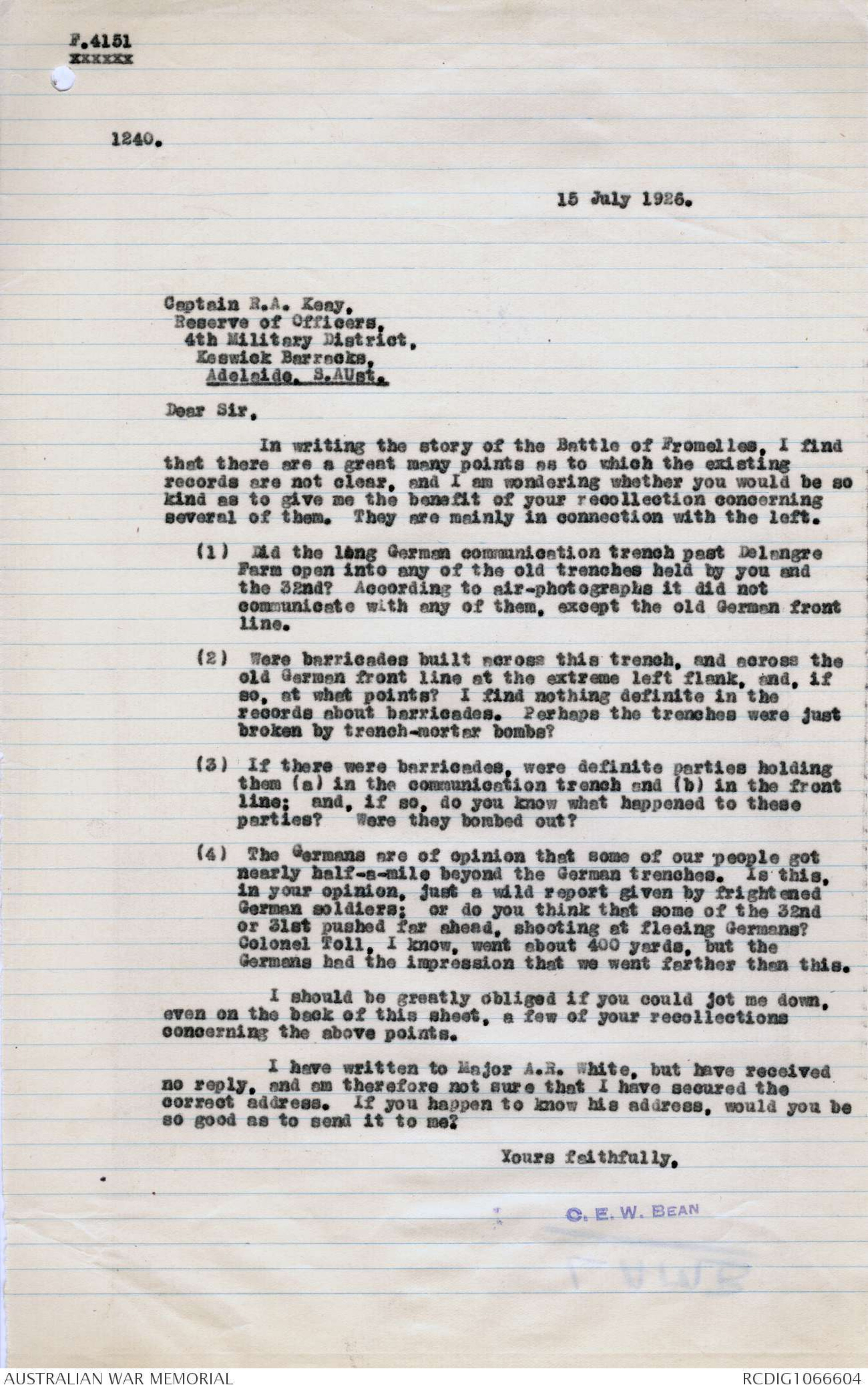
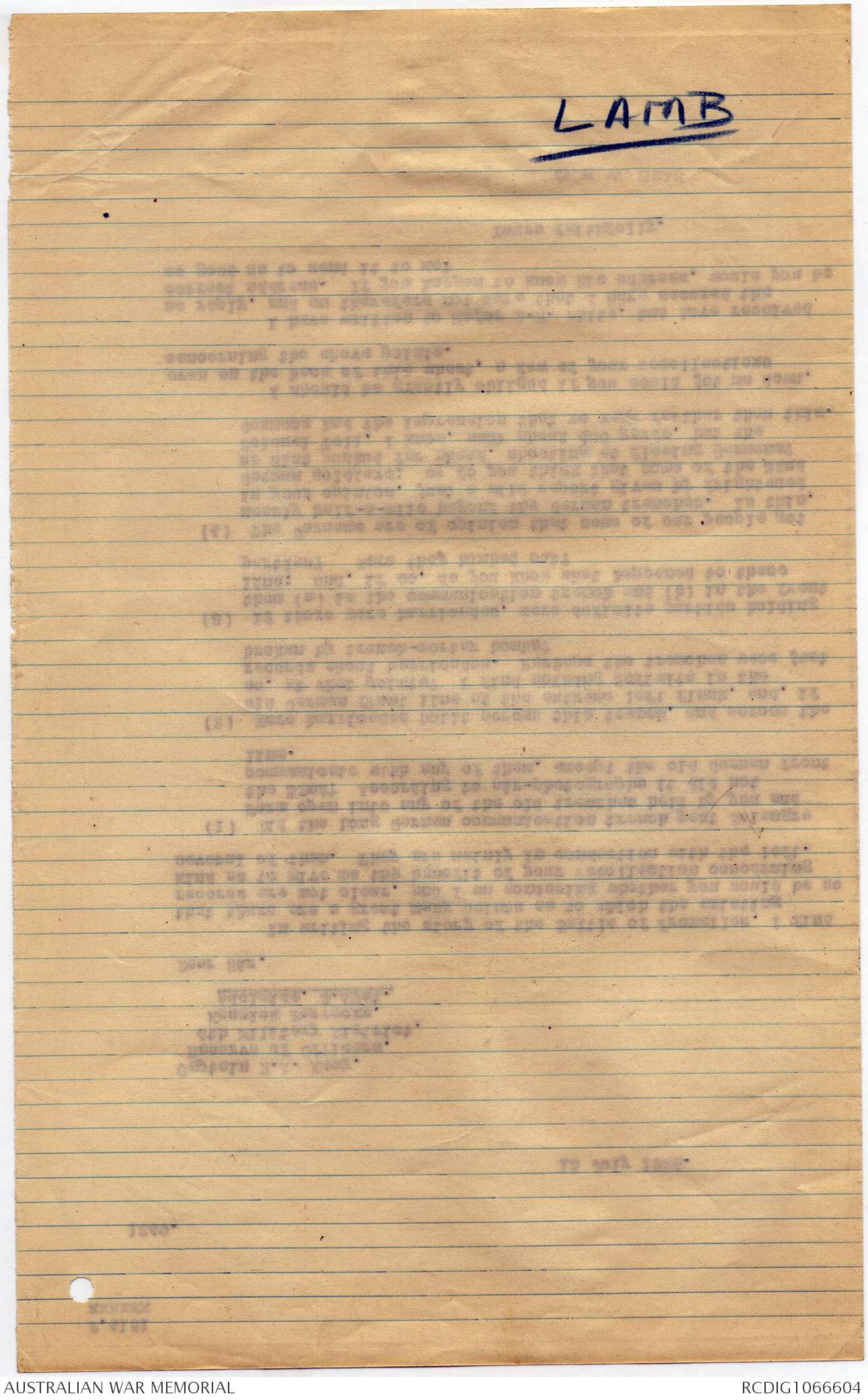
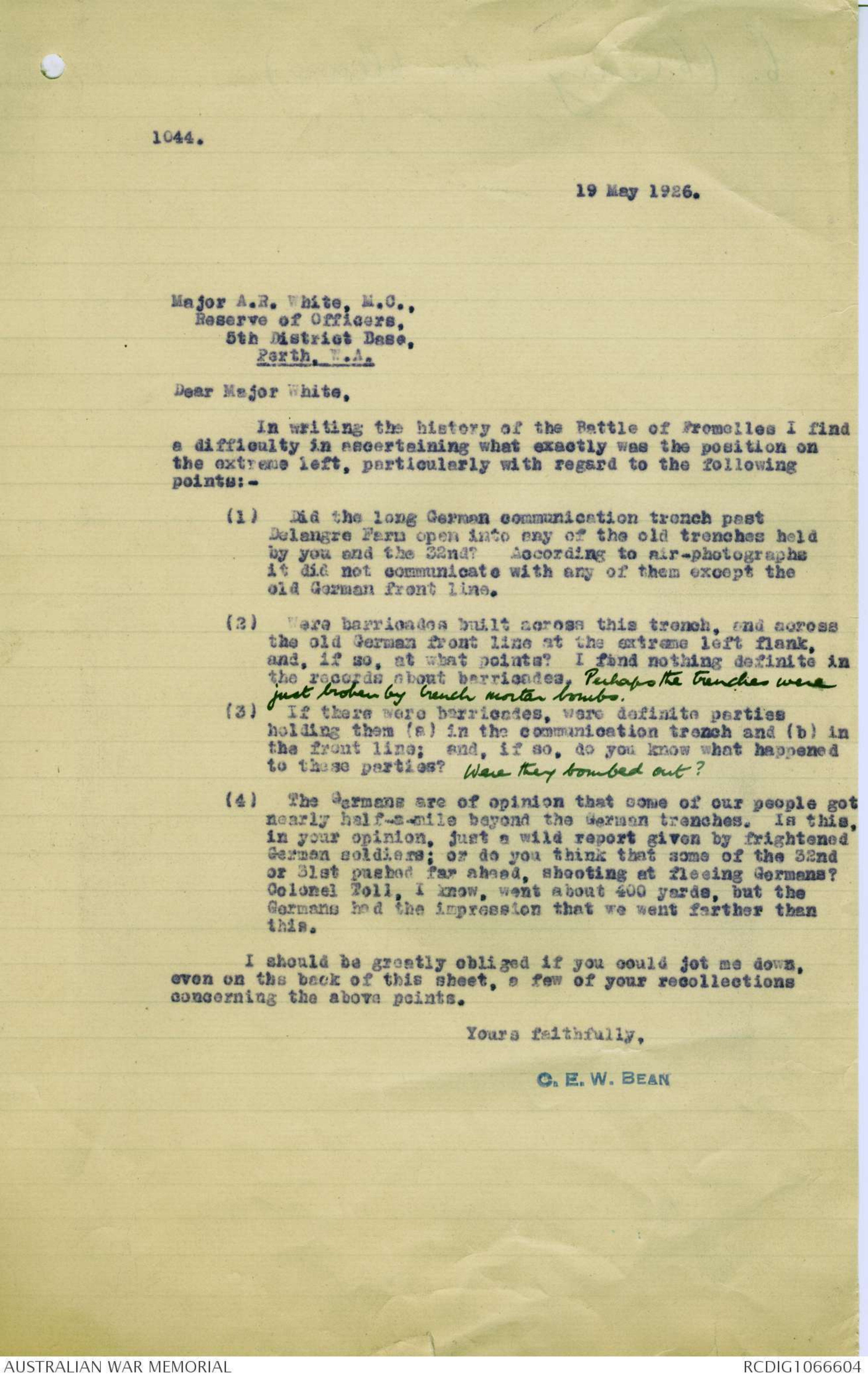
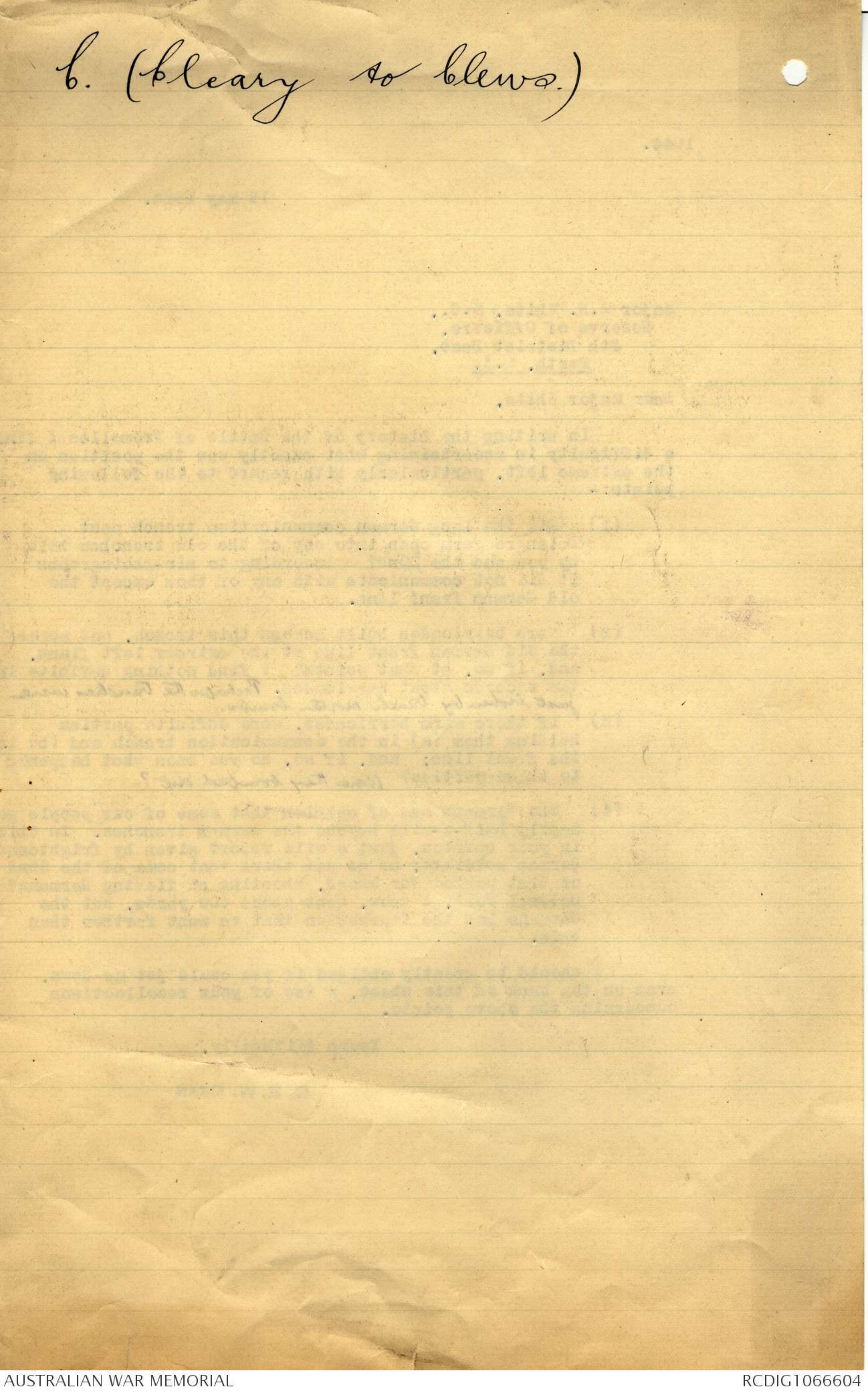
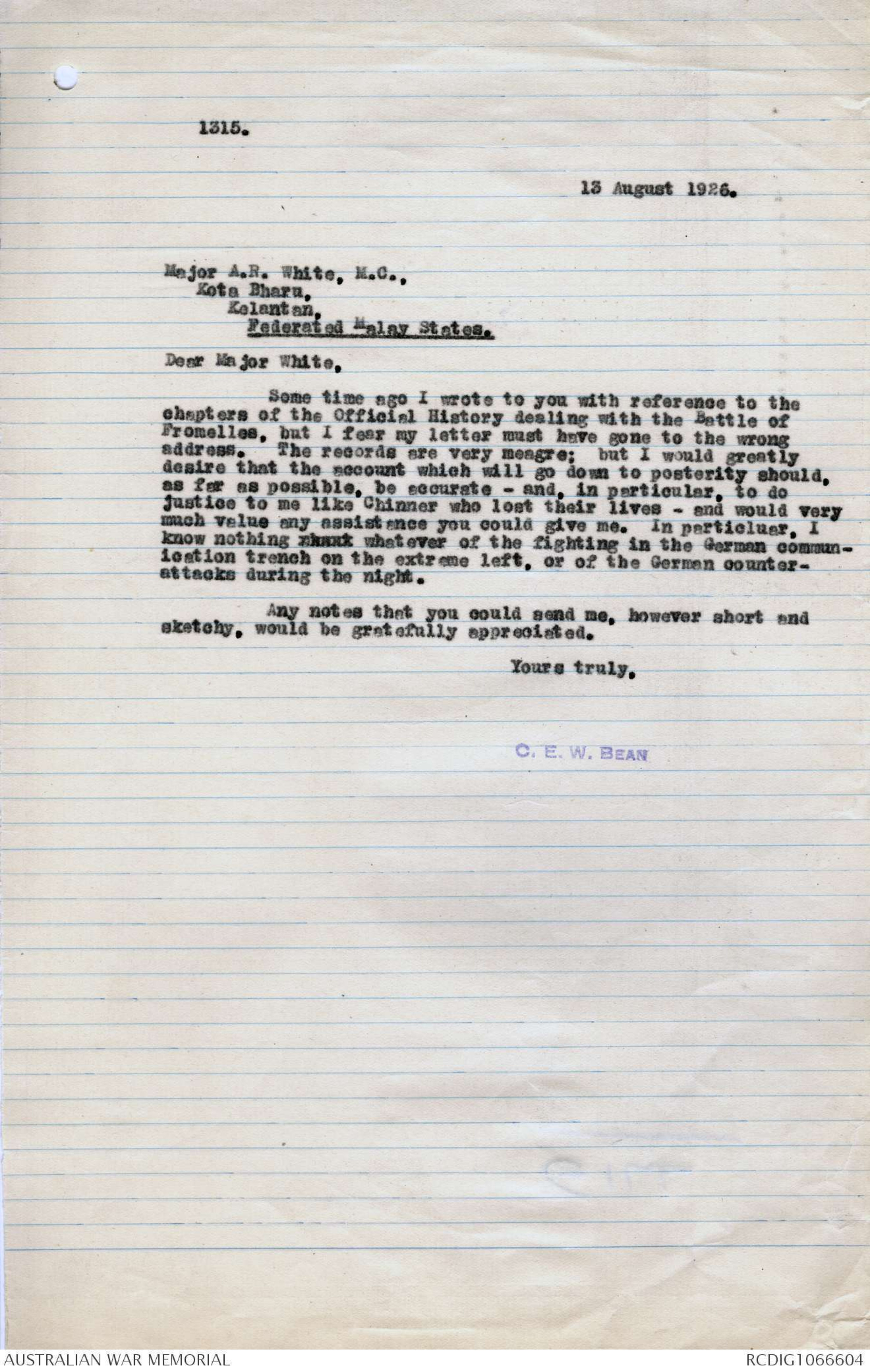
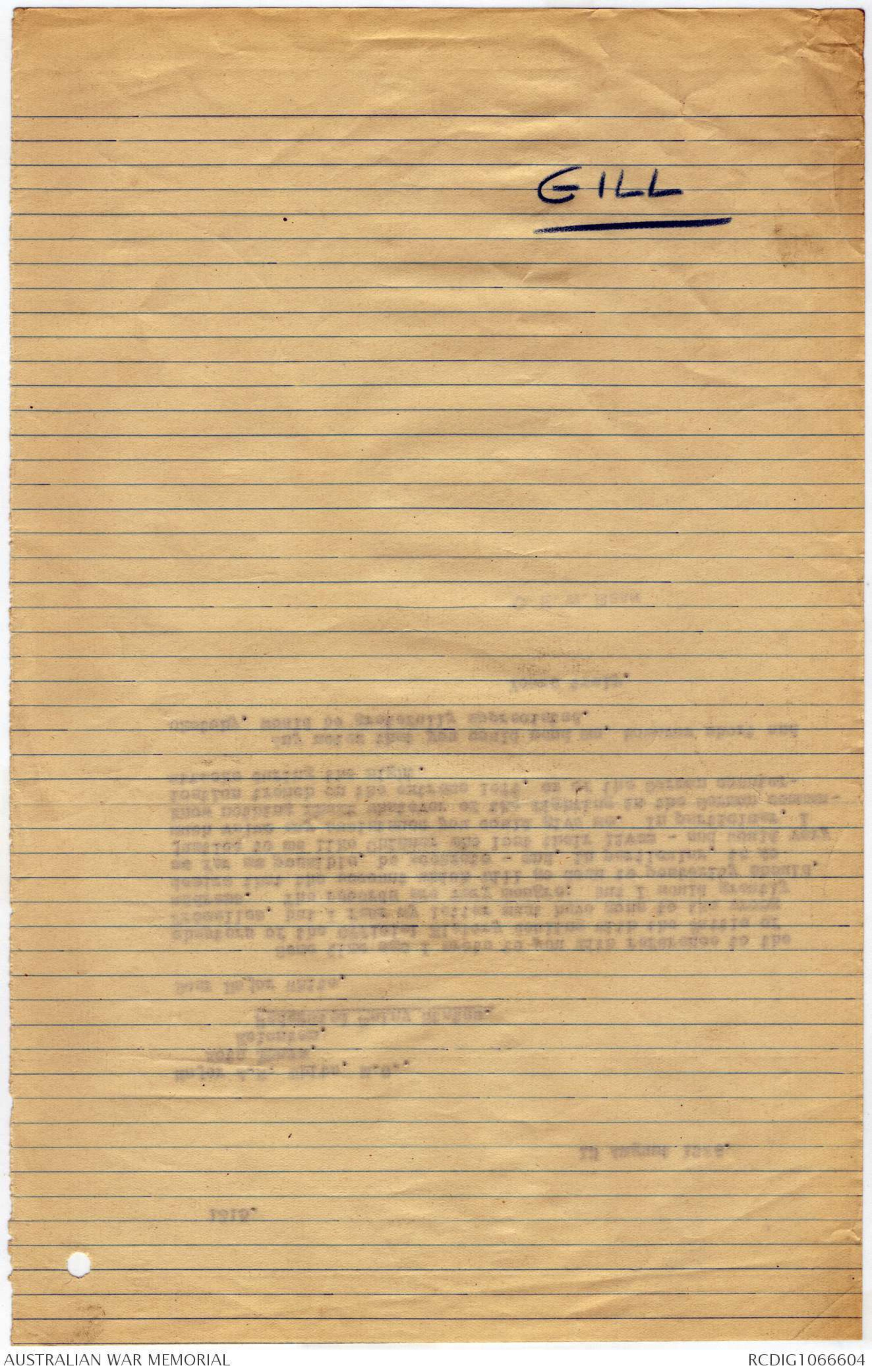
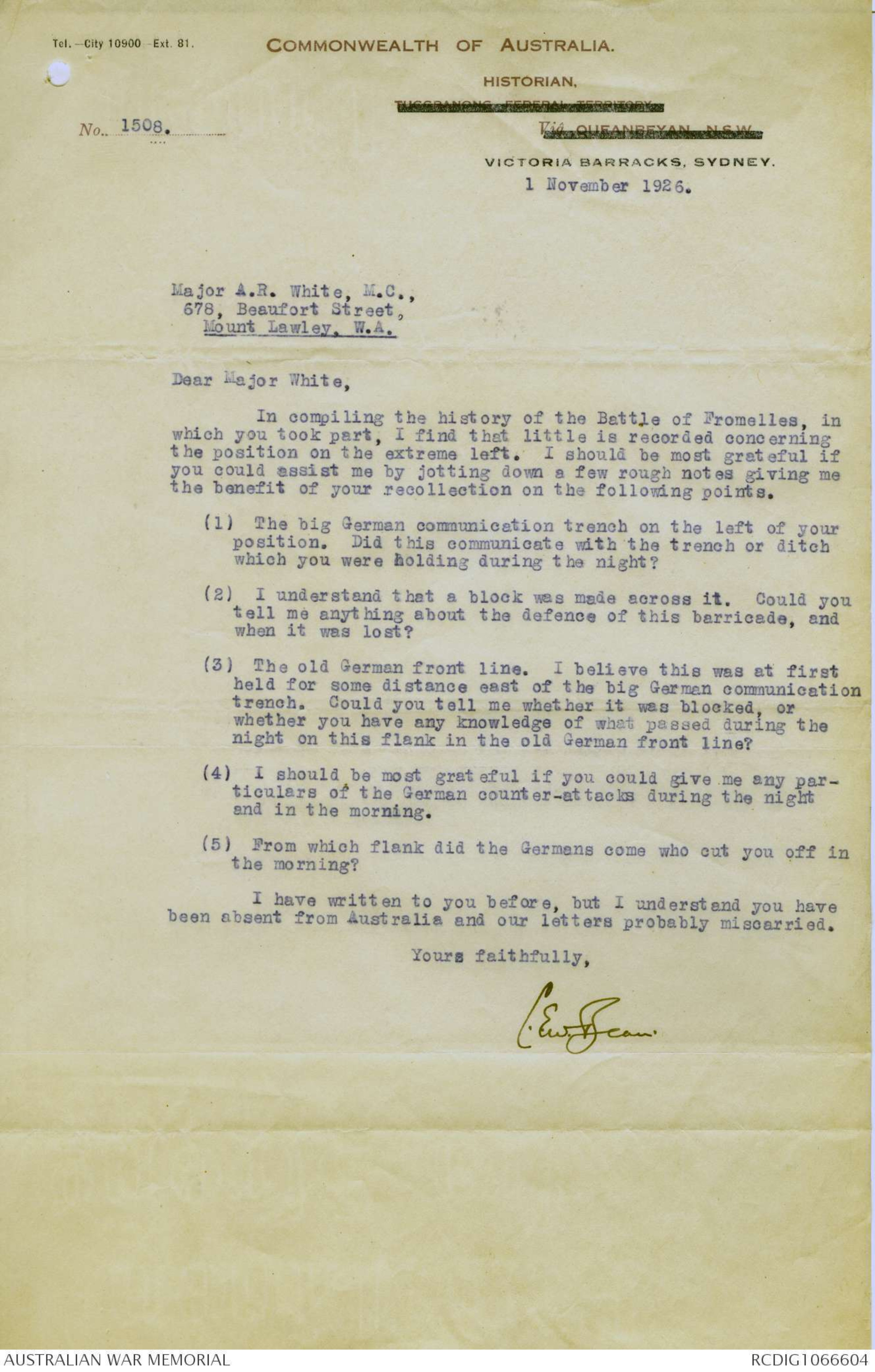
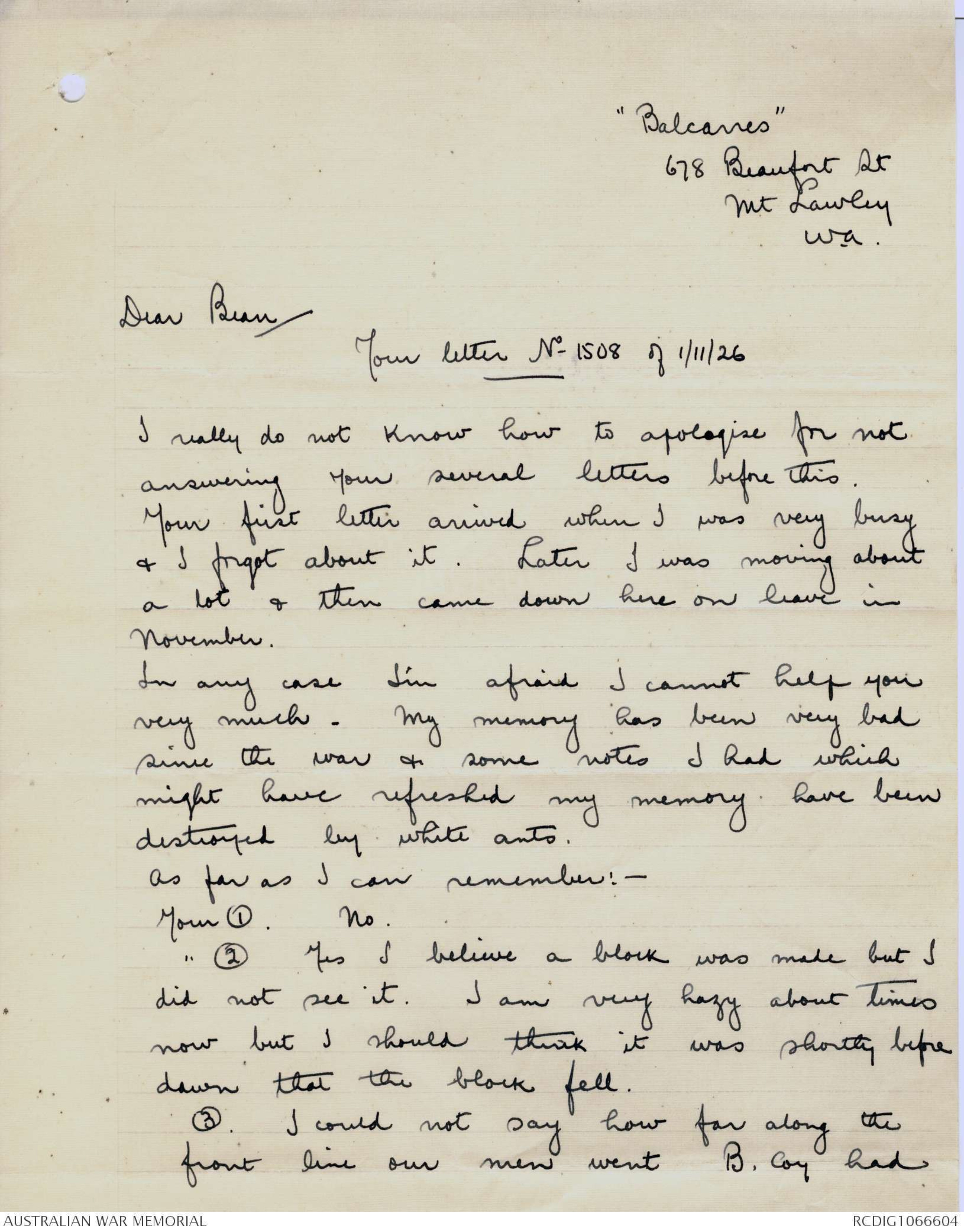
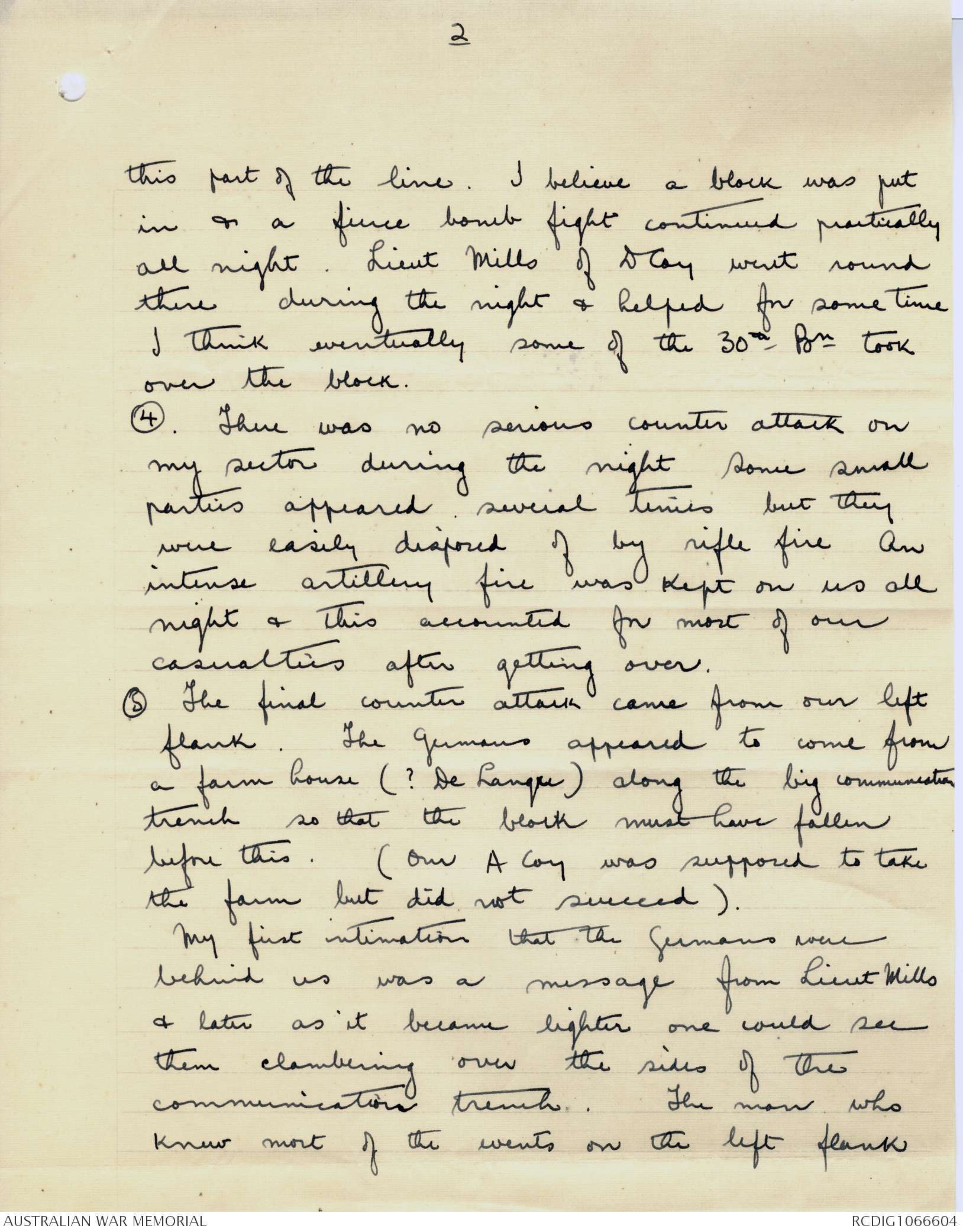
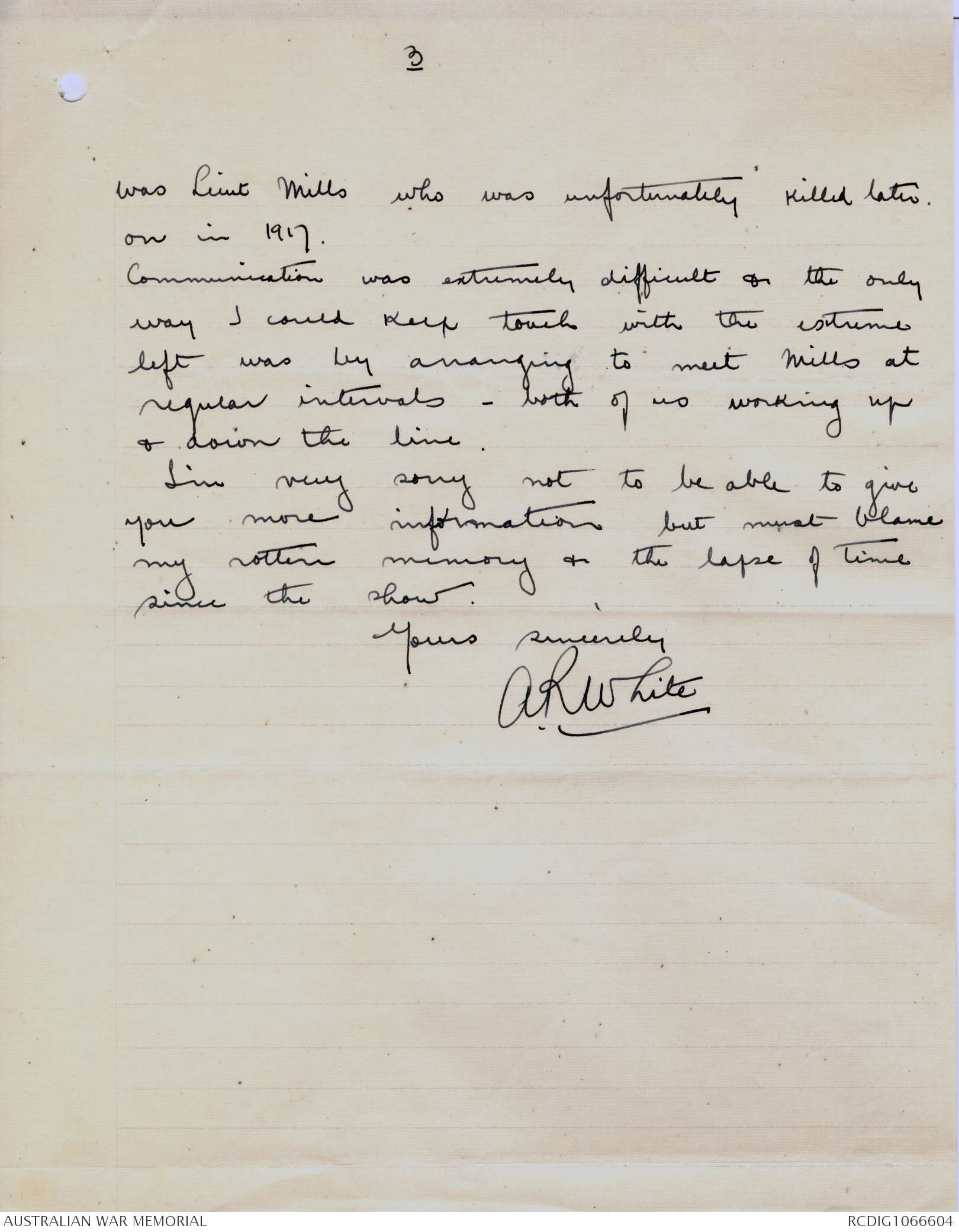
F.4151
xxxxxx
1240.
15 July 1926.
Captain R.A. Keay,
Reserve of Officers,
4th Military District,
Keswick Barracks,
Adelaide, S.AUst.
Dear Sir,
In writing the story of the Battle of Fromelles, I find
that there are a great many points as to which the existing
records are not clear, and I am wondering whether you would be so
kind as to give me the benefit of your recollection concerning
several of them. They are mainly in connection with the left.
(1) Did the long German communication trench past Delangre
Farm open into any of the old trenches held by you and
the 32nd? According to air-photographs it did not
communicate with any of them, except the old German front
line.
(2) Were barricades built across this trench, and across the
old German front line at the extreme left flank, and, if
so, at what points? I find nothing definite in the
records about barricades. Perhaps the trenches were just
broken by trench-mortar bombs?
(3) If there were barricades, were definite parties holding
them (a) in the communication trench and (b) in the front
line; and, if so, do you know what happened to these
parties? Were they bombed out?
(4) The Germans are of opinion that some of our people got
nearly half-a-mile beyond the German trenches. Is this,
in your opinion, just a wild report given by frightened
German soldiers; or do you think that some of the 32nd
or 31st pushed far ahead, shooting at fleeing Germans?
Colonel Toll, I know, went about 400 yards, but the
Germans had the impression that we went farther than this.
I should be greatly obliged if you could jot me down,
even on the back of this sheet, a few of your recollections
concerning the above points.
I have written to Major A.R. White, but have received
no reply, and am therefore not sure that I have secured the
correct address. If you happen to know his address, would you be
so good as to send it to me?
Yours faithfully,
C.E.W. BEAN
LAMB
1044.
19 May 1926.
Major A.R. White, M.C.,
Reserve of Officers,
5th District Base,
Perth, W.A.
Dear Major White,
In writing the history of the Battle of Fromelles I find
a difficulty in ascertaining what exactly was the position on
the extreme left, particularly with regard to the following
points:-
(1) Did the long German communication trench past
Delangre Farm open into any of the old trenches held
by you and the 32nd? According to air-photographs
it did not communicate with any of them except the
old German Front Line.
(2) Were barricades built across this trench, and across
the old German front line at the extreme left flank,
and, if so, at what points? I find nothing definite in
the records about barricades. Perhaps the trenches were
just broken by trench mortar bombs.
(3) If there were barricades, were definite parties
holding them (a) in the communication trench and (b) in
the front line; and, if so, do you know what happened
to these parties? Were they bombed out?
(4) The Germans are of opinion that some of our people got
nearly half-a-mile beyond the German trenches. Is this,
in your opinion, just a wild report given by frightened
German soldiers; or do you think that some of the 32nd
or 31st pushed far ahead, shooting at fleeing Germans?
Colonel Toll, I know, went about 400 yards, but the
Germans had the impression that we went farther than
this.
I should be greatly obliged if you could jot me down,
even on the back of this sheet, a few of your recollections
concerning the above points.
Yours Faithfully,
C.E.W. BEAN
C. (Cleary to Clews.)
1315.
13 August 1926.
Major A.R. White, M.C.,
Kota Bharu,
Kelantan,
Federated Malay States.
Dear Major White,
Some time ago I wrote to you with reference to the
chapters of the Official History dealing with the Battle of
Fromelles, but I fear my letter must have gone to the wrong
address. The records are very meagre; but I would greatly
desire that the account which will go down to posterity should,
as far as possible, be accurate - and, in particular, to do
justice to me like Chinner who lost their lives - and would very
much value any assistance you could give me. In particluar, I
know nothing xxxxx whatever of the fighting in the German communication
trench on the extreme left, or of the German counter-attacks
during the night.
Any notes that you could send me, however short and
sketchy, would be gratefully appreciated.
Yours truly,
C.E.W. BEAN
GILL
Tel.—City 10900 - Ext. 81.
COMMONWEALTH OF AUSTRALIA.
HISTORIAN,TUGGRANONG FEDERAL TERRITORYVia QUEANBEYAN N.S.W.
No.. 1508.
VICTORIA BARRACKS, SYDNEY.
1 November 1926.
Major A.R. White, M.C.,
678, Beaufort Street,
Mount Lawley, W.A.
Dear Major White,
In compiling the history of the Battle of Fromelles, in
which you took part, I find that little is recorded concerning
the position on the extreme left. I should be most grateful if
you could assist me by jotting down a few rough notes giving me
the benefit of your recollection on the following points.
(1) The big German communication trench on the left of your
position. Did this communicate with the trench or ditch
which you were holding during the night?
(2) I understand that a block was made across it. Could you
tell me anything about the defence of this barricade, and
when it was lost?
(3) The old German front line. I believe this was at first
held for some distance east of the big German communication
trench. Could you tell me whether it was blocked, or
whether you have any knowledge of what passed during the
night on this flank in the old German front line?
(4) I should be most grateful if you could give me any particulars
of the German counter-attacks during the night
and in the morning.
(5) From which flank did the Germans come who cut you off in
the morning?
I have written to you before, but I understand you have
been absent from Australia and our letters probably miscarried.
Yours faithfully,
C.E.W. Bean.
"Balcanes"
678 Beaufort St
Mt Lawley
w.a.
Dear Bean
Your letter No 1508 of 1/11/26
I really do not know how to apologise for not
answering your several letters before this.
Your first letter arrived when I was very busy
& I forgot about it. Later I was moving about
a lot & then came down here on leave in
November.
In any case I'm afraid I cannot help you
very much. My memory has been very bad
since the war & some notes I had which
might have refreshed my memory have been
destroyed by white ants.
As far as I can remember:-
Your 1. No.
" 2 Yes I believe a block was made but I
did not see it. I am very hazy about times
now but I should think it was shortly before
dawn that the block fell.
3. I could not say how far along the
front line our men went B. Coy had
2
this part of the line. I believe a block was put
in & a fierce bomb fight continued practically
all night. Lieut Mills of D Coy went round
there during the night & helped for some time
I think eventually some of the 30th Bn took
over the block.
4. There was no serious counter attack on
my sector during the night Some small
parties appeared several times but they
were easily disposed of by rifle fire An
intense artillery fire was kept on us all
night & this accounted for most of our
casualties after getting over.
5 The final counter attack came from our left
flank. The Germans appeared to come from
a farm house (? De Lanqu) along the big communication
trench so that the block must have fallen
before this. (Our A Coy was supposed to take
the farm but did not succeed).
My first intimation that the Germans were
behind us was a message from Lieut Mills
& later as it became lighter one could see
them clambering over the sides of the
communication trench. The man who
knew most of the events on the left flank
3
was Lieut Mills who was unfortunately killed later.
on in 1917.
Communication was extremely difficult & the only
way I could keep touch with the extreme
left was by arranging to meet Mills at
regular intervals - both of us working up
& down the line.
I'm very sorry not to be able to give
you more information but must blame
my rotten memory & the lapse of time
since the show.
Yours sincerely
A.R White
 Deb Parkinson
Deb ParkinsonThis transcription item is now locked to you for editing. To release the lock either Save your changes or Cancel.
This lock will be automatically released after 60 minutes of inactivity.